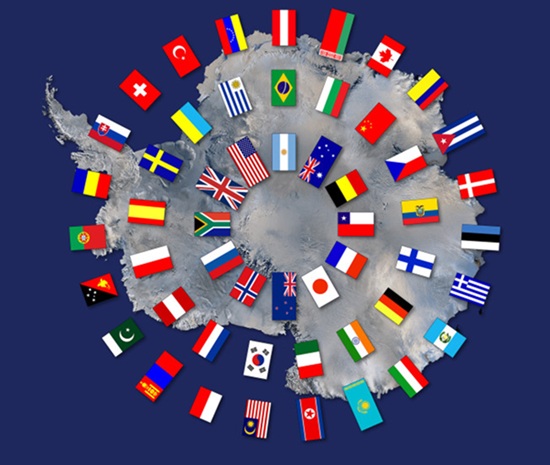| GS Paper -III : Environment and Ecology |
Why in Discussion ?
- India recently hosted the 46th Antarctic Treaty Consultative Meeting (ATCM) and the 26th Committee for Environmental Protection (CEP) in Kochi, Kerala.
- These meetings were organized by the National Centre for Polar and Ocean Research (NCPOR), Goa, under the Ministry of Earth Sciences, Government of India.
- Key discussions focused on climate change, marine biodiversity, environmental protection, and scientific collaboration.

Background and Origin
- During the Cold War, Antarctica—the last unexplored continent—attracted the attention of several countries.
- In the 1950s, countries like the USA, USSR, UK, Argentina, Chile, Australia, and New Zealand made territorial claims.
- During the International Geophysical Year (1957–58), multiple countries conducted joint scientific expeditions.
- Inspired by this spirit of collaboration, 12 countries signed an international treaty in Washington in 1959, laying the foundation of the Antarctic Treaty System (ATS).
Key Features of the Treaty
|
Feature
|
Description
|
|
Date of Enforcement
|
1 June 1961
|
|
Signing Venue
|
Washington, D.C.
|
|
Original Signatories
|
12 countries – USA, USSR, UK, France, Norway, Australia, New Zealand, Argentina, Chile, Japan, Belgium, South Africa
|
|
Current Members
|
57 (29 Consultative + 28 Non-Consultative)
|
|
India’s Membership
|
1983 (as Consultative Party)
|
|
Geographical Scope
|
Entire region south of 60°S latitude
|
Main Objectives of the Treaty
- Peaceful Use Only:
- Military activities, weapon testing, or bases are prohibited.
- Ban on Nuclear Explosions & Waste
- Freedom of Scientific Research:
- Open international collaboration and data sharing.
- Suspension of Sovereignty Claims:
- No new territorial claims are recognized.
- Inspection Regime:
- Member countries can inspect each other’s research stations to maintain transparency.
Antarctic Treaty System (ATS)
A multi-layered legal framework evolved from the treaty:
- Antarctic Treaty (1959) – Main treaty
- CCAS (1972) – Convention for the Conservation of Antarctic Seals
- CCAMLR (1980) – Convention on the Conservation of Antarctic Marine Living Resources
- Madrid Protocol (1991) – Protocol on Environmental Protection:
- Declares Antarctica as a “natural reserve dedicated to peace and science.”
- Complete ban on mining activities.
- Effective from 1998.
Geographical and Ecological Features
- Fourth-largest continent: 14 million sq km.
- 98% ice-covered, average thickness ~1.6 km.
- Ross Sea: Largest marine protected area in the world.
- Ice Shelves: Thwaites, Larsen, Pine Island – rapidly melting.
- Average Temperature: -49°C (coastal summer: -2°C to -10°C).
Role in Global Climate
- Global Thermostat: Maintains Earth’s albedo (reflectivity).
- Ocean Circulation: Antarctic Circumpolar Current (ACC) – largest ocean current.
- Carbon Sink: Absorbs millions of tons of CO₂ annually.
- Impact on Sea Levels: Melting could raise sea levels by ~58 meters.
Emerging Threats
|
Threat
|
Impact
|
|
Climate Change
|
Rapid ice-sheet melting; rising sea levels
|
|
Ocean Acidification
|
Negative impact on marine biodiversity
|
|
Human Activities
|
Pollution from research stations
|
|
Tourism
|
Over-tourism causing ecological imbalance
|
|
Fishing
|
Over-harvesting of krill disrupts food chain
|
India’s Role and Initiatives
|
Year
|
Initiative
|
|
1981
|
First Indian Antarctic Expedition
|
|
1983
|
Dakshin Gangotri Station (now inactive)
|
|
1989
|
Maitri Station – permanent research center
|
|
2012
|
Bharati Station – modern multidisciplinary facility
|
|
2022
|
Indian Antarctic Act, 2022 – legal framework for Indian activities
|
|
2024 (Planned)
|
Maitri-II Station – new research center
|
Indian Antarctic Act, 2022
- Purpose:
- Regulate activities of Indian citizens and institutions in Antarctica.
- Mandatory Environmental Impact Assessment (EIA).
- Ensure waste management, species protection, and environmental preservation.
- Penalties: imprisonment of 5–20 years for violations.
Strategic and Scientific Importance for India
- Scientific Gains:
- Climate modeling, glacial and polar studies, mineral research.
- Geopolitical Advantage:
- Preparing for future resource competition; strengthens India’s polar research leadership.
- Diplomatic Benefit:
- Active ATS participation positions India as a global environmental governance leader.
Criticisms and Challenges
|
Challenge
|
Description
|
|
Pressure for Resource Exploitation
|
Future mining or energy exploration may increase
|
|
Tourism Regulation
|
Over 100,000 tourists in 2024 – environmental risk
|
|
Conflicting Interests
|
Rising presence of China & Russia creates tension
|
|
Insufficient Climate Measures
|
Current protocols lack binding emission reductions
|
Additional Facts
- Antarctica covers ~20% of the Southern Hemisphere.
- No indigenous population or countries exist.
- Mount Erebus on Ross Island: southernmost active volcano.
- Antarctica Desert: one of the driest deserts globally.
- Crucial for global temperature balance and the "ocean conveyor belt."
- Flora: lichens, mosses, terrestrial algae.
- Fauna: blue, fin, humpback, right, minke, sei, sperm whales, leopard seals, penguins.
- Supports breeding of 100 million+ birds, seals, sea lions, and other marine mammals.
Conclusion
- The Antarctic Treaty is a model of supreme international cooperation, where peace, science, and environmental protection are prioritized despite geopolitical competition.
- In the era of climate change, polar melting, and resource rivalry, its importance has grown.
- India’s active engagement and initiatives like Maitri-II reflect not only scientific advancement but also a strong commitment to sustainable global governance.



